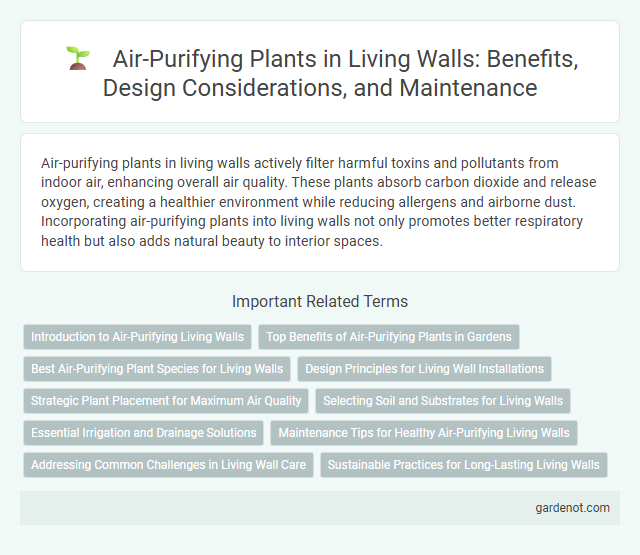Air-purifying plants in living walls actively filter harmful toxins and pollutants from indoor air, enhancing overall air quality. These plants absorb carbon dioxide and release oxygen, creating a healthier environment while reducing allergens and airborne dust. Incorporating air-purifying plants into living walls not only promotes better respiratory health but also adds natural beauty to interior spaces.
Introduction to Air-Purifying Living Walls
Air-purifying living walls integrate specialized plants known for their ability to filter indoor pollutants such as formaldehyde, benzene, and ammonia. These vertical gardens use plant species like spider plants, peace lilies, and English ivy to enhance air quality while promoting a healthier living environment. Incorporating air-purifying plants in living walls also contributes to humidity regulation and noise reduction in indoor spaces.
Top Benefits of Air-Purifying Plants in Gardens
Air-purifying plants in gardens significantly improve outdoor air quality by filtering pollutants such as formaldehyde, benzene, and ammonia. These plants increase oxygen levels and humidity, creating a healthier microclimate while reducing airborne allergens and toxins. Incorporating species like spider plants, peace lilies, and Boston ferns in living walls promotes respiratory health and enhances overall garden aesthetics.
Best Air-Purifying Plant Species for Living Walls
Spider plants (Chlorophytum comosum) are highly effective for living walls due to their ability to remove formaldehyde and carbon monoxide. Peace lilies (Spathiphyllum) excel at filtering benzene, trichloroethylene, and mold spores, making them ideal for improving indoor air quality. Boston ferns (Nephrolepis exaltata) contribute to reducing indoor air pollutants by increasing humidity and capturing airborne toxins.
Design Principles for Living Wall Installations
Selecting air-purifying plants such as Spider Plant, Peace Lily, and Boston Fern enhances indoor air quality by naturally filtering pollutants. Design principles for living wall installations emphasize optimal plant placement to maximize light exposure, airflow, and moisture levels, ensuring healthy growth and efficient purification. Incorporating modular panels and automated irrigation systems supports maintenance and sustainability in urban environments.
Strategic Plant Placement for Maximum Air Quality
Strategic plant placement in living walls maximizes air quality by utilizing species with high VOC absorption and pollutant filtration capabilities near air entry points. Positioning air-purifying plants such as spider plants, peace lilies, and Boston ferns in zones with optimal light and airflow enhances their photosynthetic efficiency and toxin removal performance. Integrating a diverse mix of plant species tailored to specific indoor pollutants creates a synergistic effect that significantly improves overall indoor air purification.
Selecting Soil and Substrates for Living Walls
Selecting the right soil and substrates for living walls is crucial for maximizing the air-purifying capabilities of plants such as spider plants, pothos, and peace lilies. Lightweight, well-draining substrates like coconut coir, perlite, and peat moss provide optimal aeration and moisture retention, supporting healthy root systems and enhancing pollutant absorption. Incorporating activated charcoal can further improve air quality by filtering toxins and reducing odors within indoor environments.
Essential Irrigation and Drainage Solutions
Air-purifying plants in living walls require essential irrigation and drainage solutions to maintain optimal moisture levels and prevent root rot. Automated drip irrigation systems paired with well-designed drainage layers ensure consistent water delivery and effective runoff, promoting healthy plant growth. Proper integration of these systems supports air purification by enhancing plant vitality and longevity within urban green spaces.
Maintenance Tips for Healthy Air-Purifying Living Walls
Regular watering tailored to the specific needs of air-purifying plants like pothos, spider plants, and peace lilies ensures optimal growth and air quality. Pruning dead or yellowing leaves prevents disease and promotes vigorous foliage, enhancing the wall's air filtration capabilities. Using a balanced, water-soluble fertilizer once a month supports sustained nutrient uptake and vibrant plant health in living walls.
Addressing Common Challenges in Living Wall Care
Air-purifying plants used in living walls, such as spider plants and pothos, effectively reduce indoor air pollutants like formaldehyde and benzene, improving air quality. Ensuring proper irrigation systems prevents root rot, a common challenge caused by overwatering or poor drainage. Regular monitoring of light exposure and humidity levels is essential to maintain plant health and optimize the air-purifying benefits of living walls.
Sustainable Practices for Long-Lasting Living Walls
Air-purifying plants such as pothos, spider plants, and peace lilies enhance indoor air quality by filtering toxins while supporting sustainable living wall systems. Utilizing water-efficient irrigation and eco-friendly substrates minimizes resource consumption and promotes plant health for extended durability. Integrating native, low-maintenance species further reduces environmental impact and ensures long-lasting, resilient living wall installations.
Air-purifying plant Infographic

 gardenot.com
gardenot.com